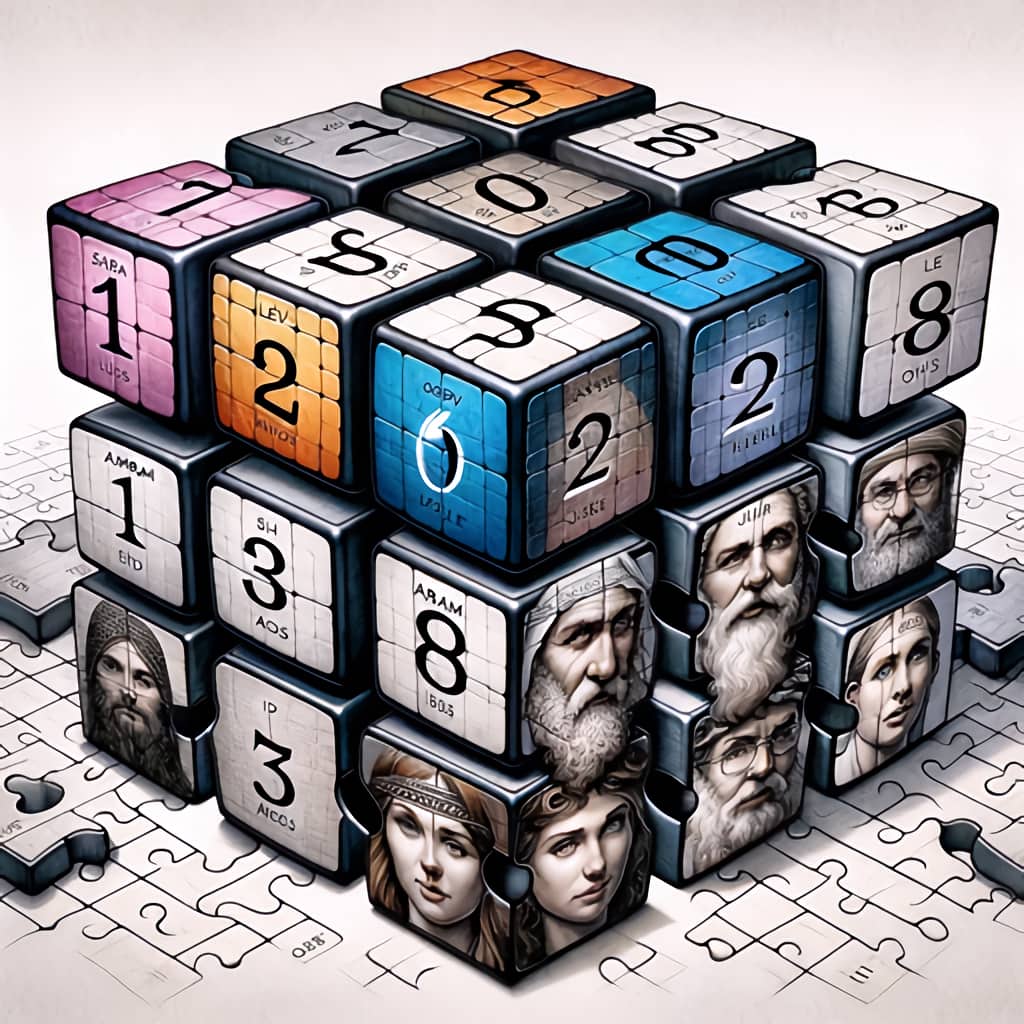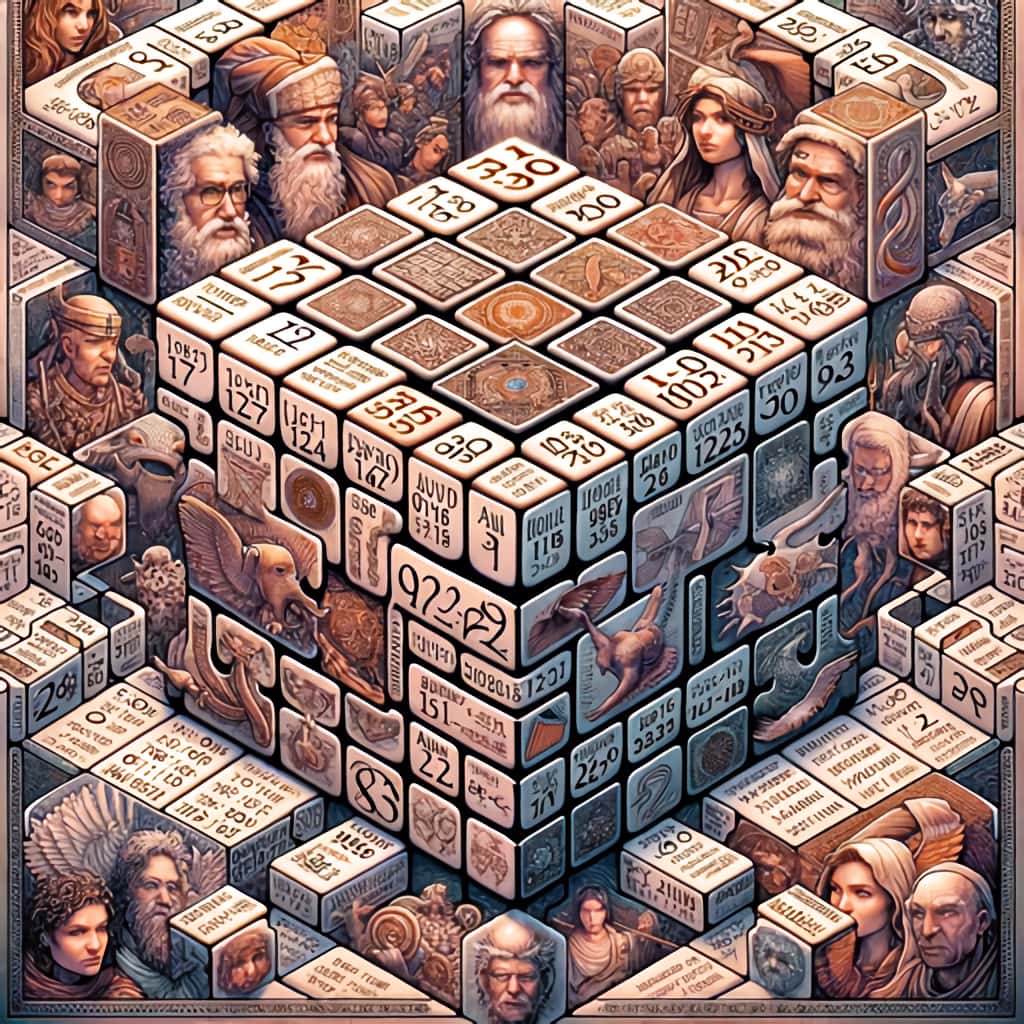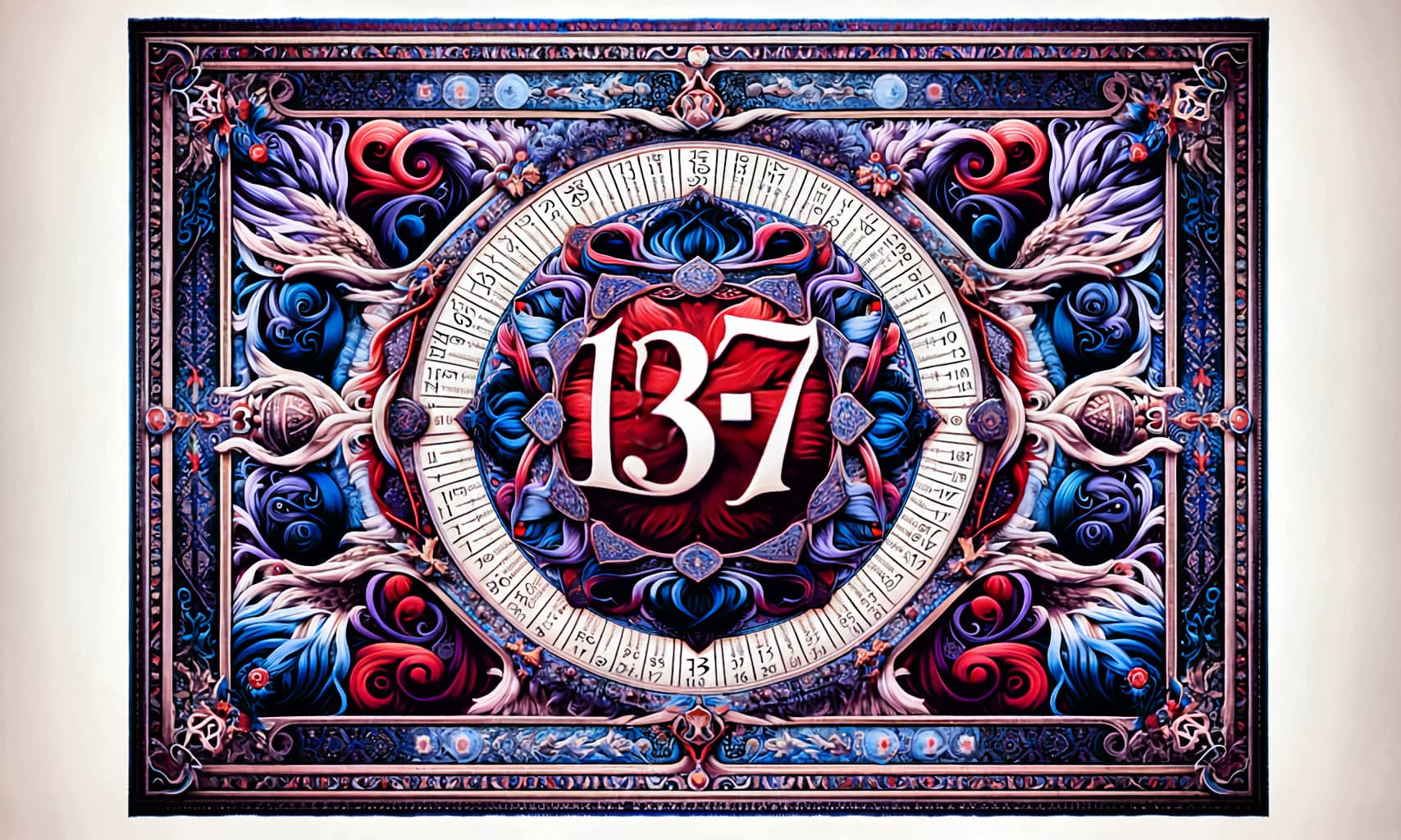Numbers are not merely figures but threads weaving a story of redemption
The below image of the tapestry (with caption) is from a major article that packs a punch on its own
The Redemption Tapestry’s details could unfold into a book, evidently crafted by an intelligent force. But which intelligence? Scholars across ages, perhaps in Babylonian captivity 2500 years ago, or divine influence exceeding human skill? Doubters are invited to verify each fact and then, through careful contemplation, judge the true source of this intricate work.
The patterns in the caption represent just half the narrative, which is fully realized when each date is mirrored with an “AD” counterpart—for instance, “4114 BC” for Creation aligns with AD 4114, and 1406 BC corresponds with AD 1406. This mirroring unveils the tapestry’s rich symmetrical design and, like a fractal, merges flawlessly with the “Long Chronology” (“14466 BC” to AD 1406), using the “Key of 23.”
Curiously, “1/137” holds scientific weight, mirroring facets of Creation.
Ishmael, Levi, and Amram each died at 137 years, reflecting the seven days of Creation plus Seth’s birth after 130 years. At Sarah’s death, Abraham was 137. The New Testament and Septuagint have two Cainans, with a combined age of 1370 years, with their births 1370 (-2) apart. Cainan1 lived 130×7 years and fathered a son at 70; Cainan2 fathered at 130. Caianan2 carried on in the sin of the angels that rebelled “in the days of Jarod” (Bk. Jub., Bk Enoch).
Adam was 460 years old when Jarod was born (see “Key of 23“), paralleling Cainan2, born 460 years after Cainan1 died. “460 years” later, Cainan2 died—the same year Abraham left Babylon for Canaan. The Israelites entered Canaan half-1370 years later, in 1406 BC. Still, another half-1370 years later, in 722/721 BC, the Northern Kingdom of Israel, like the angels who sinned, fell into exile—1370 from when Abraham left Babylon to go to Canaan that coincided with Cainan and Terah’s death!
Here is a mystery: Canaan’s 1370 was divided in half, as was Cainan1&2, because Noah cursed Canaan, Gen 9:25. On the cross, Christ, in Canaan, as Cainan—unfallen Cainan1 became fallen Cainan2 that we might become Cainan1, and so the Lamb as 70 & 130, slain before the world, ever bears his mark as 137. This wordplay casts a shadow: Abraham had a brother named “Harran.” Harran died in Babylon and did not enter the land of Haran. Their father, Terah, died in Haran and did not enter Canaan. Thus, Abraham left Harran in Babylon and Terah in Haran to go to Canaan in the year Cainan2 died, Genesis 11:27-32. Moreover, Ham, a son of Shem, had sons—Canaan and Egypt.
Noah cursed Canaan at his birth, one year after the Flood—4831 BC in the Long Chronology. From the curse to Abraham’s entry into Canaan is 1370+1370 years. The inclusion of Cainan2 (130+330=460) adjusts Canaan’s curse back 460 years to 5291/5289 BC, and the Reg. Chron. to 3919 BC for Cainan1. This aligns 1370 years to Cainan1 and twice that to Cainan2, merging “Long” and regular chronologies for Cainan1 by 7800 years (130×60, with ±130×7) & Cainan2 by 2300 (460×5, with ±460), Dan. 8:13-14, but with LXX-215 =1260+1260, Rev. 11-12, & 1150 between Cainans.
Recall the connection to Jared when Adam was 460. In the Long Chronology, the span from Jarod to Cainan2 is 4600, and 1150×3 more years passed before entering Canaan (9456-4856-1406 BC, for a total of 7×1150).
As for the Flood date of 5291/4831 BC, that’s 23/21×230 to Christ (Key of 23) and 4900 to AD 70 (the fall of Jerusalem, Dan. 9). Then there’s the BC/AD mirror! See Long Chronology Chart and Regular Chart for reference.

Is it possible that the complex patterns depicted above, symbolized by the Rubik’s Cube, were the work of scholarly collectives during the Babylonian Exile?
At first glance, one might consider these designs products of human ingenuity. Yet, upon closer examination and witnessing the escalating complexity—illustrated in the visual below—it becomes clear that the sophistication involved surpasses human ability.
After more than thirty years of rigorous study and numerous articles, I assert confidently that the insights presented here merely skim the surface of an immense, intricately interlocked puzzle.


Satan is afraid of a bold church,,,,,,but not afraid of a scared church…..2000 years ago, the church was bold, and the demons were terrified of Jesus and the Church,,,,,,Today, in this Great FINAL APOSTASY OF THE CHURCH, the church is afraid of losing their friends, so they preach a watered-down Gospel……
Elijah, Jesus, the 12 Apostles, the 70, Paul, the early church, were bold, and they preached with authority.. Luke 9;1.
2 Thess 2;3
There is a long pause (summertime) between the Jewish Spring Holydays and the Fall Holydays,,,,,which is the fore-shadow of the long pause of the Church age from 30 AD to 2025 AD…..so the OT predicts the long Church Age between the FIRST ADVENT OF CHRIST and the SECOND COMING.
Christ is our Passover – he saved us from death.
Christ is our First Fruits – he is our Resurrection.
Christ is our Tabernacles – he will abide with us in the Golden City with extreme rejoicing.
Praise Christ!
The greatest thing about Israel is—-Israel points us to our Savior, the LORD JESUS CHRIST……..Who will save us from the second death, the lake of fire,,,,,,,,,,PRAISE CHRIST!
Israel brought us the OT, NT, Law of Moses, Law of Christ, Messiah, many FULFILLED PROPHECIES, PROOFS, amazing symbolism, witness, SIGNS, WONDERS, MIRACLES, FORE-SHADOWS, ……….faith comes from reading the WORD OF GOD, written by Israel.
9-11– 01 …… world trade center collapse , Twin Towers fell……..
9 – 11-08 ….. world trade collapse…. Congress spent 700 billion dollars to guarantee the toxic subprime mortgages to save World Commerce……….bible-codes.org
9-11–1994….. small Cessna airplane hit the White House. The pilot was Frank Eugene Corder. It was the foreshadow of 9 – 11-01. This was the foreshadow of the plane that fell in the Pennsylvania field on 9-11-01.
TISHA B’AV (9th of Av) is written as 9-11 in the Jewish calendar. 9-11 is all about APOSTASY. Solomon’s Temple fell because Israel was in APOSTASY at that time. Herod’s Temple fell because Israel was in APOSTASY at that time (they rejected Jesus). The Twin Towers fell because the Church, as a whole, was in Apostasy at that time (the Church loves FREE STOLEN MONEY, Marxism, National Debt, Redistribution, Obamacare, Socialism, ). 2 Thess 2;3 is the GREAT FINAL APOSTASY of the Church which allows the Antichrist to arise.
in the Old Testament, the Israelites helped the poor because they must do it—it was required by the Law.
But in the New Testament, we Christians are Not required—-we help the poor because we love the poor. The NT is infinitely better than the OT. The OT was a mere Shadow of the NT Substance (Colossians 2;16)……..We are unselfish Love, God-like Love. We were changed from sons of Satan to Sons of God. PRAISE CHRIST!
About 3 months before SADDAM HUSSEIN died, I was following DEAN COOMBS on bible-codes.org ………by bible code, he predicted the date of HUSSEIN’s death, and the method of death (noose, like Haman in the Book of Esther)…….I marked the date on my calendar, and the prophecy was fulfilled perfectly…….I was shocked and delighted,,,,,,,,my faith was greatly strengthened,,,,,,,I had never seen a miracle before,,,,,,,,I am eye witness of FULFILLED PROPHECY, which is the proof that Jesus is the only true God. See Isaiah 46;9-10. Only Jesus can predict the future like He can.
Jesus is sending SIGNS AND WONDERS to strengthen our faith for soon endtimes persecutions. Praise Christ! Jesus is testing our faith.
Is there a discord or other forum type community for this information? I think it would be really beneficial to talk to like minded people.
Thank you for your question. Funny you mention it. For a number of years, I moderated a forum for just such a thing—back 20 years ago. But it consumed too much time, so I moved on. However, from time to time, I wonder if that was a good move. Sorry I cannot be of further help.
by the river of babylon, i sit down, and weep, when i remember ZION,,,,,,,,,,,
today’s church is in spiritual captivity to satan,,,,,,,,in this endtimes apostasy……..2 THESS 2;3…..
and a remnant shall Return to Zion to rebuild the TEMPLE,,,,,,a temple of living stones, whose CORNERSTONE AND CAPSTONE IS JESUS CHRIST!
Wow praise God for your wonderful intelligence and everything you have done here.
Beautiful.
Just wonderful cube.
Thanks for your ongoing encouragement! It’s been a tough slug.
I came across a very interesting video which shows really incredible numeric patterns in the KJV – over 50 of which only came about with the changing of language (e.g. thy self becoming one word) and once the KJV was standardised (e.g. LORD vs Lord).
The patterns are hard to dismiss, it’s as though God pre-arranged the translation, and I thought you may be interested.
It’s titled “The 1611th Mention of LORD (And Why It’s a Really Big Deal)” by a youtuber called ‘Truth is Chris’.
Thank you for sharing. I believe that because God orchestrates all things down to the atom, it’s no surprise that order is hidden in chaos everywhere. The challenge lies in discerning what is useful information and what is not—a lesson I’ve learned the hard way.
Looks like the mirror of earthquakes and Tsunami in Japan 1/1/2024 from December 26, 2004 like you mentioned long ago.
Dear Dean,
You have an incredible amount of info and resources on your site. I find it overwhelming and confusing. I believe the point of any biblical research is to develop and strengthen our relationship with God thorough Christ Jesus. I did not find any mention or references to Jesus. Admittedly i did not go thorough the entire site, At the end of the day, Jesus is all that matters and the only way to the Father and eternal life.
I have spent the last 4 years developing a Timeline and manuscript that started with the Abraham Accords peace treaty and has been extremely accurate to date. I would like to attach it to an email and get you take on it. I do not have a website yet thought I am working a physical version. It’s main point is that Jesus is returning very soon and we must through much tribulation enter the Kingdom of God. I believe the pre-trib rapture concept to be blasphemy, I believe we will be here for the rise of the Antichrist and His Beast System. I believe most Christians are not prepared and that there names can and will be removed from the Book of Life if the Worship the AC and participate in his soon to be implemented system of control. I currently believe that approximately 99% of the world does not have a strong enough relationship with Jesus to keep them out of Hell! Please allow me to send or email you a copy of what I call The Revelation Tribulation Timeline.
Dear Scott,
Thank you for your thoughtful comment. I wholeheartedly agree with the importance of focusing on Christ, and this is indeed the foundation of every article on my site, including the one you are commenting on. While you may not have seen explicit mentions of Jesus, the ultimate goal of my research is to illuminate His significance and the fulfillment of God’s plan through Him.
For example, the article concludes with:
“As for the Flood date of 5291/4831 BC, that’s 23/21×230 to Christ (Key of 23) and 4900 to AD 70 (the fall of Jerusalem, Dan. 9). Then there’s the BC/AD mirror! See Long Chronology Chart and Regular Chart for reference.”
I understand that navigating through extensive content can be overwhelming, and I appreciate your patience.
Wishing you all the best in your endeavors.
In Christ,
Dean
Thank you Dean for all your work.